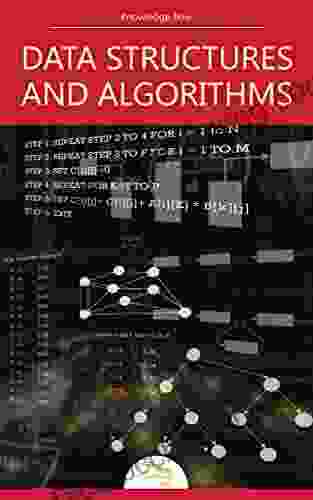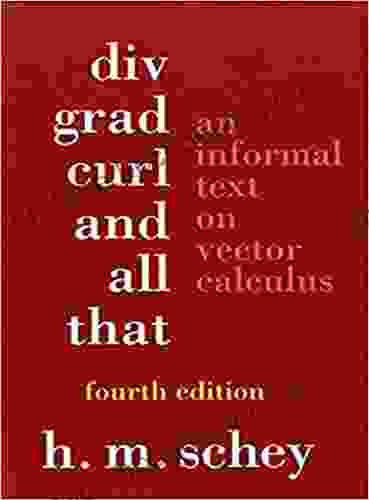Dive into the Depths of Vector Calculus: A Comprehensive Guide to Div Grad Curl and All That

<meta name="viewport" content="width=device-width, initial-scale=1.0"> <meta name="keywords" content="vector calculus, divergence, gradient, curl, Laplacian, differential geometry, electromagnetism, fluid dynamics"> <link rel="stylesheet" href="style.css"> Vector calculus is a branch of mathematics that deals with the properties of vector fields. Vector fields are mathematical objects that assign a vector to each point in a space. They are used to describe a wide variety of physical phenomena, such as the flow of fluids, the motion of charged particles, and the propagation of electromagnetic waves. The three most important operations in vector calculus are the divergence, the gradient, and the curl. The divergence of a vector field measures the net outward flux of the field from a given point. The gradient of a vector field measures the rate of change of the field in a given direction. The curl of a vector field measures the circulation of the field around a given point. In this article, we will provide a comprehensive overview of the concepts of divergence, gradient, curl, and the Laplacian. We will also discuss some of the applications of these concepts in physics and engineering. <h2>Divergence</h2> The divergence of a vector field is a measure of the net outward flux of the field from a given point. It is defined as the limit of the flux of the field through a small surface divided by the volume of the surface as the surface shrinks to a point. The divergence of a vector field can be used to identify sources and sinks of the field. A source is a point where the divergence of the field is positive, indicating that the field is flowing outward from the point. A sink is a point where the divergence of the field is negative, indicating that the field is flowing inward toward the point. For example, the divergence of the velocity field of a fluid is equal to the rate at which the fluid is expanding or contracting. A positive divergence indicates that the fluid is expanding, while a negative divergence indicates that the fluid is contracting. <h2>Gradient</h2> The gradient of a vector field is a measure of the rate of change of the field in a given direction. It is defined as the vector that points in the direction of the greatest rate of change and has a magnitude equal to the rate of change. The gradient of a vector field can be used to find the direction of maximum increase or decrease of the field. It can also be used to find the level curves or surfaces of the field, which are the curves or surfaces along which the field has a constant value. For example, the gradient of the temperature field in a room points in the direction of the greatest rate of increase in temperature. The level curves of the temperature field are the isotherms, which are the curves along which the temperature is constant. <h2>Curl</h2> The curl of a vector field is a measure of the circulation of the field around a given point. It is defined as the limit of the circulation of the field around a small loop divided by the area of the loop as the loop shrinks to a point. The curl of a vector field can be used to identify vortices or swirling motions in the field. A vortex is a point where the curl of the field is non-zero, indicating that the field is circulating around the point. For example, the curl of the velocity field of a fluid is equal to twice the angular velocity of the fluid. A non-zero curl indicates that the fluid is rotating. <h2>Laplacian</h2> The Laplacian of a vector field is a measure of the divergence of the gradient of the field. It is defined as the sum of the second partial derivatives of the field with respect to each of the coordinate axes. The Laplacian of a vector field can be used to identify regions of the field where the field is changing rapidly. It can also be used to solve a variety of differential equations. For example, the Laplacian of the temperature field in a room is equal to the rate at which the temperature is changing with respect to time. A non-zero Laplacian indicates that the temperature is changing rapidly. <h2>Applications</h2> The concepts of divergence, gradient, curl, and the Laplacian have a wide variety of applications in physics and engineering. Here are a few examples: * **Electromagnetism:** The divergence of the electric field is equal to the charge density, while the curl of the magnetic field is equal to the current density. * **Fluid dynamics:** The divergence of the velocity field is equal to the rate at which the fluid is expanding or contracting, while the curl of the velocity field is equal to twice the angular velocity of the fluid. * **Heat transfer:** The Laplacian of the temperature field is equal to the rate at which the temperature is changing with respect to time. * **Elasticity:** The Laplacian of the displacement field is equal to the force per unit volume acting on the material. Divergence, gradient, curl, and the Laplacian are fundamental concepts in vector calculus. They are used to describe a wide variety of physical phenomena and have a wide variety of applications in physics and engineering. This article has provided a comprehensive overview of these concepts. For more information, please refer to the references below. <h2>References</h2> * [Vector Calculus](https://en.wikipedia.org/wiki/Vector_calculus) * [Divergence](https://en.wikipedia.org/wiki/Divergence) * [Gradient](https://en.wikipedia.org/wiki/Gradient) * [Curl](https://en.wikipedia.org/wiki/Curl_(mathematics)) * [Laplacian](https://en.wikipedia.org/wiki/Laplacian)4.6 out of 5
| Language | : | English |
| File size | : | 23949 KB |
| Print length | : | 176 pages |
Do you want to contribute by writing guest posts on this blog?
Please contact us and send us a resume of previous articles that you have written.
 Book
Book Novel
Novel Page
Page Chapter
Chapter Text
Text Story
Story Genre
Genre Reader
Reader Library
Library Paperback
Paperback E-book
E-book Magazine
Magazine Newspaper
Newspaper Paragraph
Paragraph Sentence
Sentence Bookmark
Bookmark Shelf
Shelf Glossary
Glossary Bibliography
Bibliography Foreword
Foreword Preface
Preface Synopsis
Synopsis Annotation
Annotation Footnote
Footnote Manuscript
Manuscript Scroll
Scroll Codex
Codex Tome
Tome Bestseller
Bestseller Classics
Classics Library card
Library card Narrative
Narrative Biography
Biography Autobiography
Autobiography Memoir
Memoir Reference
Reference Encyclopedia
Encyclopedia Keith Law
Keith Law Govert Schilling
Govert Schilling Glenn Tinnin
Glenn Tinnin Sheila Willcox
Sheila Willcox Hugh Aldersey Williams
Hugh Aldersey Williams Kate Mcmillan
Kate Mcmillan Greg Nelson
Greg Nelson Thomas Bulfinch
Thomas Bulfinch Hank D Haney
Hank D Haney Grace Olmstead
Grace Olmstead Lex Levinrad
Lex Levinrad Hanya Yanagihara
Hanya Yanagihara Hal Rubenstein
Hal Rubenstein Ronald Bergan
Ronald Bergan Shawn Mcguire
Shawn Mcguire Guillaume Haeringer
Guillaume Haeringer Kenneth Cline
Kenneth Cline Shelley Pearsall
Shelley Pearsall James Angelos
James Angelos Glenn Patron
Glenn Patron
Light bulbAdvertise smarter! Our strategic ad space ensures maximum exposure. Reserve your spot today!

 Francis TurnerProbing the Mysteries of the World's First Artists: Unraveling the Secrets of...
Francis TurnerProbing the Mysteries of the World's First Artists: Unraveling the Secrets of...
 Kevin TurnerWinter Wonderlands: A Photographic Journey into the Heart of Winter's Embrace
Kevin TurnerWinter Wonderlands: A Photographic Journey into the Heart of Winter's Embrace
 Mario BenedettiJourney Through Care of Magical Creatures: A Literary Enchantment for All...
Mario BenedettiJourney Through Care of Magical Creatures: A Literary Enchantment for All... Joel MitchellFollow ·16.3k
Joel MitchellFollow ·16.3k Gregory WoodsFollow ·4.2k
Gregory WoodsFollow ·4.2k Andy HayesFollow ·2.1k
Andy HayesFollow ·2.1k Diego BlairFollow ·19.9k
Diego BlairFollow ·19.9k Hugh ReedFollow ·14.8k
Hugh ReedFollow ·14.8k Victor HugoFollow ·7.8k
Victor HugoFollow ·7.8k Isaac AsimovFollow ·14.8k
Isaac AsimovFollow ·14.8k Ralph TurnerFollow ·16.4k
Ralph TurnerFollow ·16.4k

 Brady Mitchell
Brady MitchellMaster IELTS Speaking: The Ultimate Guide to Success
Kickstart Your IELTS...

 Branden Simmons
Branden SimmonsBack Spin: A Thrilling Myron Bolitar Novel
Get ready to embark on a...

 Marc Foster
Marc FosterData Structures and Algorithms: A Comprehensive Guide to...
In the ever-evolving...

 Jeff Foster
Jeff FosterUnveiling the Basics of Microbiology: A Comprehensive...
The world of...

 J.D. Salinger
J.D. SalingerHold Tight Suspense Thriller: A Gripping Page-Turner That...
Are you ready for a suspense thriller that...
4.6 out of 5
| Language | : | English |
| File size | : | 23949 KB |
| Print length | : | 176 pages |








